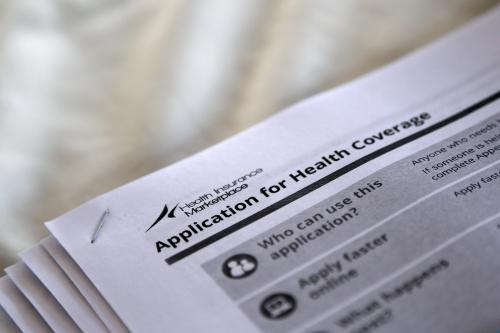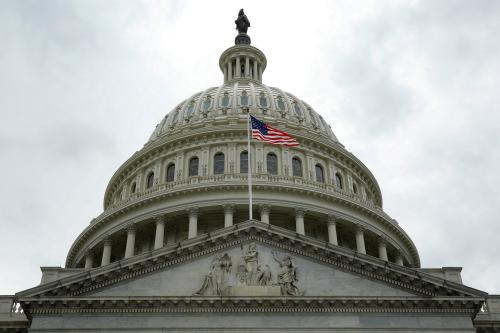Obamacare repeal is, once again, back on the congressional agenda, thanks to a final push to pass a proposal authored by Senators Bill Cassidy (R-La.) and Lindsey Graham (R-S.C.). Republicans are again using the fast-track budget reconciliation process to protect the bill from a filibuster. And like with previous efforts, the process has been irregular, including an absence of hearings and the likelihood that Congress will vote next week with only a bare-bones estimate of the bill’s effects from the Congressional Budget Office.
The politics, too, of this last-ditch effort is unusual. While we lack polling data on the Graham-Cassidy proposal specifically, previous efforts were extremely unpopular with voters, and we do not usually expect members of Congress to push so heavily for such an unpopular bill. In addition, Graham and Cassidy are taking a somewhat unusual approach in securing the votes of fifty Republican senators. That is, Graham explained that part of his strategy for building a coalition in the Senate was to build support among Republican governors. Specifically, Graham explained that “I’m hoping to have 25 Republican governors come out the next couple of weeks” in support of the bill.
Governors have played and will likely continue to play an important role in how the ACA is implemented. And so, what may seem like a commonsense strategy is in fact rather atypical. Governors are state-level elected officials; they have no formal role or authority in the federal legislative process, and they are not responsible for making federal-level decisions. For these reasons, we do not typically think of them as a constituency whose support federal-level officials seek during the legislative process.
Now, a governor might of course provide political support for a member of Congress from their state. And, it is not unusual for federal-level officeholders to inform policy decisions based on their expectations of how governors will respond, particularly when the policy at hand involves state-level implementation. As political scientist Pam McCann explains, members of Congress consider the actions that governors may take when deciding whether and how to delegate authority to the state level. And as one of us has argued, presidents appear to take into account the share of the nation’s governors who are likely to respond favorably to a president’s request for applications to waive certain federal requirements.
But Graham and Cassidy’s governor strategy is different. They are not revising the legislation based on how they think governors will implement it. And they are not simply coordinating with the governors in their states. Rather, they are treating the governors within their party as an important constituency whose support can validate an unpopular bill. Why try to convince half of the nation’s governors to support a bill that none of them is allowed to vote on?
While atypical, Graham’s logic makes some sense in this particular context. Many governors have played highly visible roles thus far in deciding whether to expand Medicaid under the ACA in their states and have joined in national discussions about repealing and replacing the ACA. To voters, this participation may confer upon governors more authority than usual to weigh in on national legislation. Leveraging this perception, perhaps Graham hoped that endorsement from roughly three-quarters of the 34 Republican governors would put a new shine on this most recent repeal and replace bill.
Is the strategy working? While the bill’s fate in the Senate will remain uncertain until next week’s vote, the figure below displays Republican governors’ positions thus far on the Graham-Cassidy proposal. The size of each bar is the projected change in federal funding (in billions) between 2020 and 2026 as a result of the bill, as estimated by the Kaiser Family Foundation (KFF). Red bars are GOP governors who have announced opposition to the bill’s ACA block grant and Medicaid per capita cap provisions, green bars indicate supporters, and grey bars correspond to governors who have not stated a firm position publicly.

First, it’s worth noting that Graham has not yet hit his 25 governor target, as only 16 GOP governors have announced their support so far. To get to 25, Graham and Cassidy would have to get nine of the ten remaining Republican governors on board, and the holdouts include three governors from states (IL, MI, and WV) that expanded Medicaid. Unsurprisingly, nine of the 16 supporters are from states that KFF projects to win (that is, get more federal money) under Graham-Cassidy. While the seven supporters from states expected to lose may seem surprising, all but two of them (the governors of Indiana and North Dakota) are term-limited such that they would not be eligible for re-election after the bill’s major funding changes would be implemented.
In the end, Graham’s decision to try to use Republican governors as a source of leverage in Congress may not matter much for the bill’s fate. Of the two senators widely seen as the remaining GOP holdouts, one (Lisa Murkowski of Alaska) is from a state with an independent governor and the other (John McCain of Arizona) was willing to buck his repeal-supporting governor in July. But as we’ve argued throughout this year’s debate, when the consequences of a policy choice vary across states by as much as repeal and replace would, we should not be surprised when governors get involved.











Commentary
Cassidy and Graham hope support from governors will validate ACA repeal bill
September 22, 2017